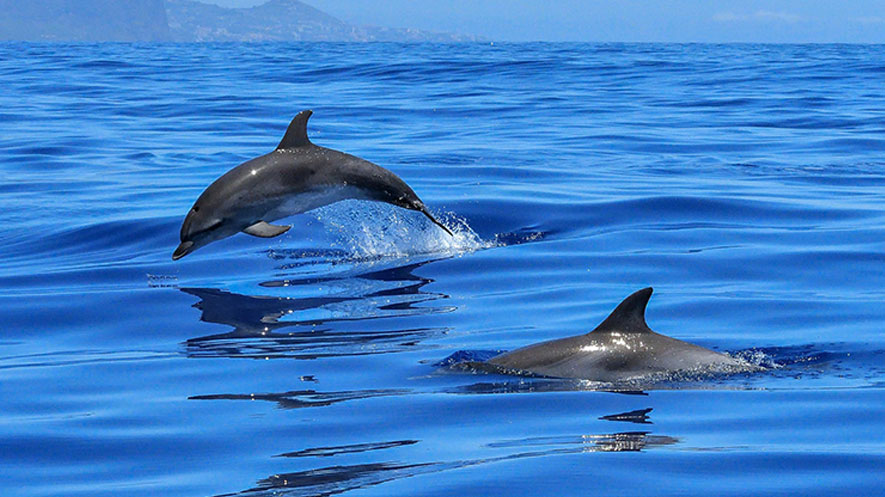Researchers have designed an automated network-based classification method to process large acoustic datasets and identify distinct dolphin click types without requiring prior knowledge of their distinguishing features. The technique is also used by Facebook and Google to estimate relationships between people or websites.
A new automated classification method can identify seven click types from over 50 million echolocation clicks recorded in the Gulf of Mexico – six clicks of unknown origin and one click belonging to the Risso’s dolphin species. A team of researchers from Scripps Institution of Oceanography, San Diego State University and NOAA NMFS Southeast Fisheries Science Center then developed an algorithm for classifying novel detections according to the identified clusters. The researchers published their findings in PLOS Computational Biology: Automated classification of dolphin echolocation click types from the Gulf of Mexico.
Dolphins emit echolocation “clicks” that bounce off underwater targets and provide them information about their surroundings. While passive acoustic monitoring (PAM) provides researchers with 24/7 techniques to detect dolphin clicks and monitor their movement regardless of weather, one of the main obstacles in using PAM is the difficulty in identifying species. Due to acoustic variability associated with the ocean environment, only a few clicks can be linked to specific species.
In the Gulf of Mexico, there are at least 13 dolphin species. Scientists have been monitoring dolphin populations since the Deepwater Horizon incident to learn about effects on them and their environment. “Marine mammals such as dolphins cover large, remote areas of the offshore ocean that we know very little about,” said study author Dr. Kaitlin Frasier. “We can think of them as indicators of ocean health, because they integrate across a lot of environmental conditions that are much more difficult to study.”
This research team used high-frequency acoustic recording packages (HARPs) to collect long-term autonomous datasets at three continental slopes and two shelf locations in the Gulf of Mexico between 2010 and 2012. The team filtered the recordings for false positives and sorted click detections into a training set (ten deployments, two per site) and a testing set (five deployments, one per site).
Using the same technique that Facebook and Google use to estimate relationships between people or web pages, the team developed an unsupervised learning strategy to identify dominant click types in the training set based on click spectral shape and inter-click interval distributions. The process automatically scanned the recordings in five-minute increments, identified click characteristics, and then identified distinct, recurrent click types for classification. The team then used the click types identified in the training set to develop an algorithm to automatically classify clicks in the test dataset.
“Each click has a small amount of information in it, but there is a lot of noise in the system. By grouping similar clicks together, we were able to identify consistent patterns,” explained Frasier. “This study used unsupervised machine learning to identify distinct types of dolphin signals in a very large (~50 terabytes) recording dataset. This is unique, because people usually analyze acoustic recordings for signals they already know. However, unsupervised learning is a strategy where the computer algorithm tells you what it found instead of you telling the algorithm what to look for.”
Future studies will require focused field work to determine which species are associated with the identified click types. “We would like to integrate this work with deep learning methods to improve our ability to identify click types in new datasets and in different regions of the world. The goal will be to get simultaneous recordings and visual identification for the different species.”
Innovations in sensor technologies have opened creative possibilities in using data about the natural world for ecological analysis. Frasier said that we are used to hearing about artificial intelligence in the context of the internet, self-driving cars, and robots, but those same technologies can be used to understand and protect our environment. “It’s fun to think about how the machine learning algorithms used to suggest music or social media friends to people could be re-interpreted to help with ecological research challenges.”
Data are publicly available through the Gulf of Mexico Research Initiative Information & Data Cooperative (GRIIDC) at doi:10.7266/N7FJ2F6S.



